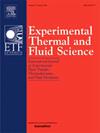Impact of a compound droplet on a solid surface: The effect of the shell on the core
IF 2.8
2区 工程技术
Q2 ENGINEERING, MECHANICAL
Experimental Thermal and Fluid Science
Pub Date : 2024-10-05
DOI:10.1016/j.expthermflusci.2024.111330
引用次数: 0
Abstract
The dynamic behavior of compound droplets impacting a solid surface was studied via experiments over (defined as the ratio of the compound droplet shell thickness h to the diameter D0 of compound droplet) ranging from 0 to 0.34, We ranging from 25 to 325 and Re ranging from 165.3 to 3405.2. The spreading diameter ratio, the maximum spreading dynamic contact angle and spreading speed of the core were investigated. Four modalities of the core of compound droplets were observed on the solid surface, including a) core rebound, b) no rebound, c) core splitting rebound, d) core splitting. The results revealed that the thickness of the shell, We, and the viscosity of the shell have a significant effect on the rebound and spreading processes of the core of the compound droplet. The high viscosity oil shell is conducive to its spreading. As the thickness of the oil shell increases, its cushioning effect on the water core also increases. In addition, and were used to divide the modal boundary of the compound droplet core. Further analysis reveals the correlation between We, Re, and.
复合液滴对固体表面的影响:外壳对核心的影响
通过实验研究了复合液滴撞击固体表面的动态行为,κ(定义为复合液滴外壳厚度 h 与复合液滴直径 D0 之比)范围为 0 至 0.34,We 范围为 25 至 325,Re 范围为 165.3 至 3405.2。研究了核心的铺展直径比、最大铺展动态接触角和铺展速度。在固体表面观察到复合液滴核心的四种模式,包括 a) 核心反弹,b) 无反弹,c) 核心分裂反弹,d) 核心分裂。结果表明,壳的厚度、We 和壳的粘度对复合液滴核心的反弹和扩散过程有显著影响。高粘度油壳有利于其扩散。随着油壳厚度的增加,其对水核的缓冲作用也会增加。此外,κ=0.02254We0.503、κ=-0.336e-We121.056+0.319 和κ=0.06086e-We121.056+0.07716e-We121.70598+0.01595 被用来划分复合液滴核心的模态边界。进一步分析发现,We、Re、βm 和.κ,12+Weβm=8+31-cos22.78+84.57κβm3+0.955We1.05Reβm6.5 之间存在相关性。
本文章由计算机程序翻译,如有差异,请以英文原文为准。
求助全文
约1分钟内获得全文
求助全文
来源期刊

Experimental Thermal and Fluid Science
工程技术-工程:机械
CiteScore
6.70
自引率
3.10%
发文量
159
审稿时长
34 days
期刊介绍:
Experimental Thermal and Fluid Science provides a forum for research emphasizing experimental work that enhances fundamental understanding of heat transfer, thermodynamics, and fluid mechanics. In addition to the principal areas of research, the journal covers research results in related fields, including combined heat and mass transfer, flows with phase transition, micro- and nano-scale systems, multiphase flow, combustion, radiative transfer, porous media, cryogenics, turbulence, and novel experimental techniques.
 求助内容:
求助内容: 应助结果提醒方式:
应助结果提醒方式:


